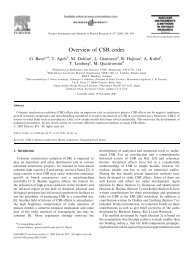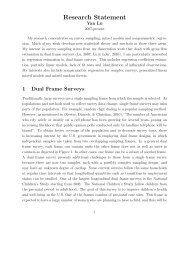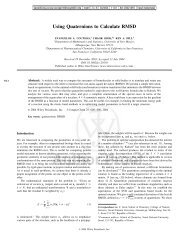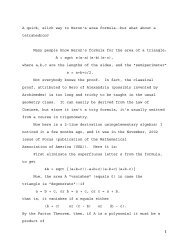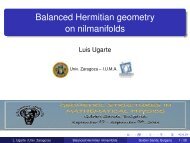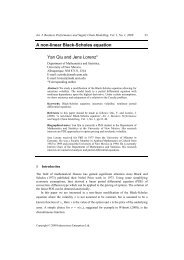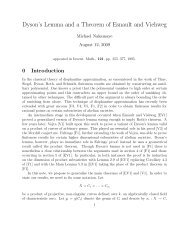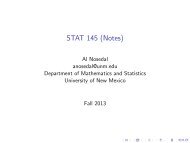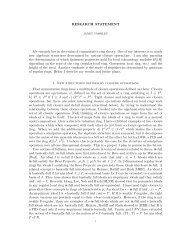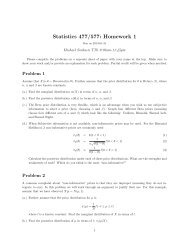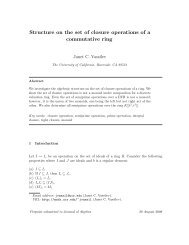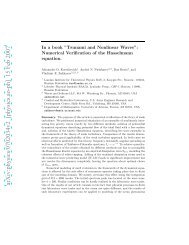OEO Office of Equal Opportunity - Department of Mathematics and ...
OEO Office of Equal Opportunity - Department of Mathematics and ...
OEO Office of Equal Opportunity - Department of Mathematics and ...
You also want an ePaper? Increase the reach of your titles
YUMPU automatically turns print PDFs into web optimized ePapers that Google loves.
PHYSICS AND ASTRONOMY 263<br />
Additional information, specific admission criteria, application<br />
forms <strong>and</strong> directions are available online at http://p<strong>and</strong>a.<br />
unm.edu.<br />
Application Deadlines<br />
International applicants <strong>and</strong> students who are seeking financial<br />
aid must submit materials no later than:<br />
Fall semester: February 1<br />
Spring semester: August 1<br />
Deadlines for domestic students who are not seeking departmental<br />
financial aid are:<br />
Fall semester: June 1<br />
Spring semester: October 1<br />
Degrees Offered<br />
M.S. in Physics<br />
The Master <strong>of</strong> Science in Physics is <strong>of</strong>fered under either<br />
Plan I (with thesis) or Plan II (without thesis). Under Plan I a<br />
minimum <strong>of</strong> 24 semester hours <strong>of</strong> graduate work in physics<br />
<strong>and</strong> mathematics (exclusive <strong>of</strong> thesis) is required. Under<br />
Plan II, 32 semester hours <strong>of</strong> graduate work in physics <strong>and</strong><br />
mathematics are to be taken. Included in this 32 hours must<br />
be at least 4 semester hours in research problems courses<br />
(551, 552, 650).<br />
Under both plans, the graduate work <strong>of</strong>fered for the master’s<br />
degree must include PHYC 503, 505, 511 <strong>and</strong> 521. In addition,<br />
if material equivalent to PHYC 466 or 467 <strong>and</strong> one <strong>of</strong> the<br />
advanced labs (PHYC 476L, 477L or 493L) is not included<br />
in the student’s prior education, these courses must also be<br />
taken for the graduate degree. Details must be discussed<br />
with a graduate advisor each semester.<br />
A master’s degree program in physics is also <strong>of</strong>fered at the<br />
Los Alamos Center for Graduate Studies.<br />
M.S. in Optical Science<br />
<strong>and</strong> Engineering<br />
Current Research areas: Advanced Materials, Atom Optics,<br />
Biomedical Optics, Fiber Optics, Laser Physics, Lithography,<br />
Nanostructures, Nonlinear Optics, Optical Imaging, Optical<br />
Sensors, Optoelectronics, Photonic Integrated Circuits,<br />
Quantum Optics, Spectroscopy, <strong>and</strong> Ultrafast Phenomena.<br />
The Optics Program is jointly administered by the <strong>Department</strong><br />
<strong>of</strong> Physics & Astronomy (P<strong>and</strong>A) <strong>and</strong> the <strong>Department</strong> <strong>of</strong><br />
Electrical & Computer Engineering (ECE). This program<br />
features an internship option under which a student can<br />
apply qualified industrial/ government laboratory research<br />
along with successfully completed course work toward the<br />
degree. Under Plan I (thesis based), a minimum <strong>of</strong> 24 hours<br />
<strong>of</strong> course work <strong>and</strong> 6 hours <strong>of</strong> thesis credit is required. Under<br />
Plan II-a (non thesis, course-based), a minimum <strong>of</strong> 33 hours<br />
<strong>of</strong> course work, including 3 hours <strong>of</strong> research seminar (PHYC<br />
500/650, least 2 <strong>of</strong> which must be in Optics – or individual<br />
research/problems (PHYC 552/650, or ECE 551/651). Under<br />
Plan II-b (internship based), a minimum <strong>of</strong> 33 hours <strong>of</strong> course<br />
work–including 3-6 hours <strong>of</strong> internship (PHYC/ECE 559-is<br />
required. Successful completion <strong>of</strong> an oral M.S. comprehensive<br />
examination is required under Plans II-a <strong>and</strong> II-b.<br />
Curriculum Requirements<br />
A. M<strong>and</strong>atory Courses<br />
1. Advanced Optics I (PHYC/ECE 463)<br />
2. Advanced Optics II (PHYC/ECE 554)<br />
3. Laser Physics I (PHYC/ECE 464)<br />
4. Optics Lab (PHYC 476L or 477L)<br />
5. Electrodynamics (PHYC 511/ECE 561)<br />
• Quantum Mechanics I (PHYC 521)<br />
• Microelectronics Processing Lab (ECE 574L)<br />
• Nonlinear Optics (PHYC 568)<br />
• Solid State Physics (PHYC 529) or Semiconductor<br />
Properties (ECE 572)<br />
• Topics in Modern Optics (PHYC 569) or Special<br />
Topics (ECE 595)<br />
• Laser Physics II (PHYC 564)<br />
• Semiconductor Lasers <strong>and</strong> LEDs (ECE 577)<br />
• Quantum Optics (PHYC 566)<br />
• Atomic <strong>and</strong> Molecular Structure (PHYC 531)<br />
• Optical Coherence Theory (PHYC 556)<br />
• Mathematical Methods in Physics (PHYC/MATH<br />
*466)<br />
• Optical Spectroscopy (CHEM 567)<br />
• Advanced Techniques in Optical Imaging (BIOL<br />
547)<br />
• Guided Wave Optics (ECE 564)<br />
• Optical Fiber Communication (ECE 565)<br />
Details must be discussed with a graduate advisor each<br />
semester.<br />
More information about the Optical Science <strong>and</strong> Engineering<br />
Program is available online: http://www.optics.unm.edu<br />
Ph.D. in Physics<br />
The Doctor <strong>of</strong> Philosophy in Physics requires a minimum<br />
<strong>of</strong> 48 semester hours <strong>of</strong> graduate work exclusive <strong>of</strong> dissertation.<br />
These hours must include PHYC 503, 505, 511,<br />
521, 522/ASTR 537, a laboratory or experimental problems<br />
course, four seminars (PHYC 500 <strong>and</strong>/or 501) <strong>and</strong> four<br />
electives chosen from a departmental list available from the<br />
student’s department advisor. Details MUST be discussed<br />
with a graduate advisor each semester. In addition, if the<br />
student has not previously taken courses equivalent to PHYC<br />
466/467, then those courses must be included in the Ph.D.<br />
course work.<br />
Ph.D. in Optical Science<br />
<strong>and</strong> Engineering<br />
Current research areas: Ultrafast optics <strong>and</strong> photonics, laser<br />
physics <strong>and</strong> engineering, optical imaging, quantum optics,<br />
optoelectronic devices, fiber lasers <strong>and</strong> amplifiers, optical<br />
communication, optical materials, optical lithography, nonlinear<br />
optics, integrated optics, quantum computing, bio-optics,<br />
nano-photonics, <strong>and</strong> laser cooling.<br />
An extensive selection <strong>of</strong> optics courses is available to the<br />
student considering graduate studies in Optical Science <strong>and</strong><br />
Engineering. Considerable interaction occurs with the Center<br />
for High Technology Materials <strong>and</strong> the optical research<br />
groups at the Air Force Research Laboratory, S<strong>and</strong>ia National<br />
Laboratories, Los Alamos National Laboratory <strong>and</strong> other<br />
organizations in Albuquerque. These facilities <strong>of</strong>fer extensive<br />
opportunities for research work toward both the M.S. <strong>and</strong> the<br />
Ph.D. degrees<br />
The Doctor <strong>of</strong> Philosophy in Optical Science <strong>and</strong> Engineering<br />
requires a minimum <strong>of</strong> 52 semester hours <strong>of</strong> graduate work<br />
exclusive <strong>of</strong> dissertation. These hours must include PHYC<br />
463, 464, 466/467, 511, 521, 554, 555 <strong>and</strong> one <strong>of</strong> 476L/477L,<br />
522, 530, 564, 566, or 569. Students are encouraged to<br />
take two semesters <strong>of</strong> PHYC 500/501 (Advanced Seminar).<br />
Details must be discussed with a graduate advisor each<br />
semester.<br />
More information about the Optical Science <strong>and</strong><br />
Engineering Program is available online: http://www.optics.<br />
unm.edu/.<br />
ARTS AND<br />
SCIENCES<br />
B. Elective Courses<br />
• Semiconductor Optoelectronic Materials <strong>and</strong><br />
Devices (ECE 570)<br />
UNM CATALOG 2006–2007 Symbols, page 611.



